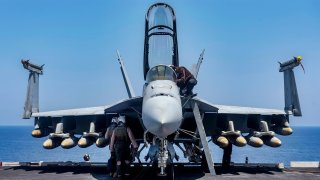Brandon J. Weichert

Summary: The US Navy faces a strategic crisis due to the rise of anti-access/area-denial (A2/AD) capabilities by adversaries like China, Russia, Iran, and North Korea. These developments challenge traditional naval power projection, particularly the effectiveness of aircraft carriers in such contested environments. To adapt, the Navy needs to embrace a new force posture focusing on stealth, submersibles, directed energy weapons, drones, and hypersonic weapons. Despite this, investment continues in aircraft carriers, overlooking the strategic advantage of submarines, especially in potential conflicts over Taiwan or the South China Sea. The Navy's current acquisition strategy, favoring expensive carriers over versatile and stealthy submarines like the Virginia-class, is criticized for not aligning with modern warfare needs. This approach risks the Navy's ability to counter A2/AD strategies effectively and calls for a shift in priorities towards more relevant and cost-effective platforms and technologies.
The US Navy is in a real crisis and they might not even realize it. Having spent decades obsessed with the aircraft carrier, the Navy appears to not have internalized the fact that America’s foes were developing capabilities to stunt the Navy’s power projection capabilities into the backyards of their rivals.
This has been especially true with China, which probably leads the world in what we know as “anti-access/area-denial” (A2/AD) capabilities. Russia, Iran, and North Korea are likely right behind China with their A2/AD systems, too.
What this means is that the Navy has no choice but to fundamentally rethink its entire force posture and the way that it fights. No longer able to move its assets within physical range of potential targets, the Navy needs to learn to leverage stealth, submersibles, directed energy weapons (DEW), drones, and hypersonic weapons together into one seamless strike package; a sort of pin to pierce the bubble that A2/AD systems create around the regions they are deployed to.
And once the bubble is burst by these long-range systems, more conventional styles of power projection can be brought to bear against the enemy.
But the Navy has put the cart before the horse.
America’s naval service continues investing in its preferred weapons system, the aircraft carrier. These expensive monstrosities are not as relevant or useful in the modern age of A2/AD as they were before the rise of A2/AD. For the Navy to retain power projection, then, it must look to other platforms.
The Navy must invest in the submarines. In fact, if and when a war with China erupts over Taiwan or the South China Sea (or both), it will be America’s submarines that become the primary method of power projection.
Subs Over Aircraft Carriers
Inherently stealthy and hard-to-track (though not impossible to track), submarines will be able to harass any Chinese invasion fleet heading toward Taiwan. If China opted for a blockade of Taiwan rather than a bloody invasion, US submarines would be key in disrupting that invasion as well. Specifically, US attack submarines, such as the costly Seawolf-class or the newer and more affordable, Virginia-class submarines.
There is already a crisis in the US submarine fleet in that the Pentagon has allowed for its submarine force to wither and atrophy—so much so that Navy shipyards are having extreme difficulty in meeting any increase in demand for more submarine builds.
Not to worry, though, the Navy has ameliorated the crisis at its shipyards by canceling the construction of planned Virginia-class submarines. Instead, the Navy is committed to building another of its new Ford-class carriers. The Ford-class aircraft carrier, by the way, costs about $13 billion to build and the first model took almost a decade to complete (those pesky shipyard issues were a real problem for the U.S.S. Gerald R. Ford as well).
The Block V Virginia-Class Sub
The Virginia-class attack submarine costs $4.3 billion per unit. The Virginia-class Block V (which was originally slated to be built for FY2025) is a marvel. This model has an insane array of features that makes it the perfect counterweight to holding Chinese and Russian forces hostage. It holds 28 Tomahawk cruise missiles (along with several other deployable weapons). The Block V variant has achieved what experts refer to as, “acoustic superiority.”
This is a key feature, considering that the primary method for tracking submarines underwater is using sonar. With the Virginia-class Block V’s acoustic superiority, though, the submarine’s stealth is enhanced. That, coupled with the larger deployable weapons capability, would grant the Navy unparalleled power projection in a domain covered by an A2/AD bubble.
The Navy was building two Virginia-class subs per year. But for Fiscal Year 2025, the Navy shocked everyone and canceled their usual order. They want only one submarine built.
Apparently, the Navy would prefer to blow through our hard-earned tax dollars to build $13 billion vanity projects, like the Ford-class, rather than build more affordable and relevant systems. The Navy, like so much of America’s elephantine military bureaucracy, is tailoring its strategy for winning the next war around its weapons rather than tailoring its weapons to meet its strategy.
China, unlike their American rivals, does not suffer from this problem.
Heck, instead of building one additional Ford-class carrier over the next eight years for $13 billion, the Navy should cancel that project and instead build three new Virginia-class submarines for almost the same amount of money!
Whatever money was left over should then be channeled into one of the Navy’s anti-A2/AD programs, such as the hypersonic weapons or DEW or drone programs.
Let us hope the Navy can reverse course quickly on its acquisition plan. Because, at this rate, it’s going to lose its opening set of engagements with any Chinese A2/AD force.
No comments:
Post a Comment